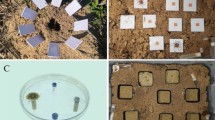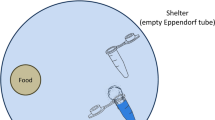Abstract
Surface treatment is commonly used in controlling the red imported fire ants, Solenopsis invicta Buren. In the present study, the behavioral responses of S. invicta workers to surfaces treated with insecticides were investigated. Toxicological tests showed that beta-cypermethrin had the highest contact toxicity (with the lowest LC50 value) among nine tested insecticides, followed by thiamethoxam, fipronil, indoxacarb, chlorfenapyr, spinetoram, rotenone, avermectin, and chlorantraniliprole. In the laboratory, surfaces treated with beta-cypermethrin or rotenone significantly reduced the number of foraging ants. In addition, S. invicta workers transported significantly more particles (measured in weight and/or covered area) onto surfaces treated with fipronil (50, 500, and 5000 µg/mL), rotenone (5000 µg/mL), or avermectin (5000 µg/mL) compared with the controls. Similarly, these insecticides significantly triggered the particle-covering behavior of ants in the field. We hypothesized that such behaviors would reduce the contact toxicity of insecticides against S. invicta. When the surfaces treated with fipronil or rotenone (500 or 5000 µg/mL) were artificiality covered with particles, S. invicta had significantly higher LT50 values compared with insecticide-treated surfaces without particles. This study provides the first evidence that S. invicta workers can perform particle-covering behavior to reduce the toxicity of certain insecticides, which constitutes a unique insecticide-resistance strategy in ants.








Similar content being viewed by others
References
Ascunce MS, Yang CC, Oakey J, Calcaterra L, Wu WJ, Shih CJ, Goudet J, Ross KG, Shoemaker DW (2011) Global invasion history of the fire ant Solenopsis invicta. Science 331:1066–1068. https://doi.org/10.1126/science.1198734
Chen J, Oi DH (2020) Naturally occurring compounds/materials as alternatives to synthetic chemical insecticides for use in fire ant management. Insects 11:758. https://doi.org/10.3390/insects11110758
Chen HY, Feng X, Lu LH, Liu J, Zhou XM, Mo Y (2006) Bioassay of contact insecticides to red imported fire ant, Solenopsis invicta Buren. Guangdong Agric Sci 5:28–30 (in Chinese)
Cole LM, Nicholson RA, Casida JE (1993) Action of phenylpyrazole insecticides at the GABA-gated chloride channel. Pestic Biochem Physiol 46:47–54. https://doi.org/10.1006/pest.1993.1035
Field LM, Davies TE, O’Reilly AO, Williamson MS, Wallace BA (2017) Voltage-gated sodium channels as targets for pyrethroid insecticides. Eur Biophys J 46:675–679. https://doi.org/10.1007/s00249-016-1195-1
Hemingway J, Field L, Vontas J (2002) An overview of insecticide resistance. Science 298:96–97. https://doi.org/10.1126/science.1078052
Hölldobler B, Wilson EO (1990) The ants. Belknap Press of Harvard University, Cambridge
Hosie AM, Baylis HA, Buckingham SD, Sattelle DB (1995) Actions of the insecticide fipronil, on dieldrin-sensitive and -resistant GABA receptors of Drosophila melanogaster. Br J Pharmacol 115:909–912. https://doi.org/10.1111/j.1476-5381.1995.tb15896.x
IRAC (2019) Mode of action classification scheme. Insecticide resistance action committee (version 9.0). www.irac-online.org
Khodaverdi H, Fowles T, Bick E, Nansen C (2016) Does drought increase the risk of insects developing behavioral resistance to systemic insecticides? J Econ Entomol 109:2027–2031. https://doi.org/10.1093/jee/tow188
Li FG, Ai GM, Li YS, Zhu CY, Gao XW (2013) Progress on mechanism of action and insecticide resistance of the oxadiazine indoxacarb in insects. Agrochemicals 52:558–560 (in Chinese)
Lofgren CS, Banks WA, Glancey BM (1975) Biology and control of imported fire ants. Annu Rev Entomol 20:1–30. https://doi.org/10.1146/annurev.en.20.010175.000245
Mao LX, Henderson G, Scherer CW (2011) Toxicity of seven termiticides on the formosan and eastern subterranean termites. J Econ Entomol 104:1002–1008. https://doi.org/10.1603/EC11005
Naqqash MN, Gökçe A, Bakhsh A, Salim M (2016) Insecticide resistance and its molecular basis in urban insect pests. Parasitol Res 115:1363–1373. https://doi.org/10.1007/s00436-015-4898-9
Ning D, Yang F, Xiao Q, Ran H, Xu Y (2019) A simple and efficient method for preventing ant escape (Hymenoptera: Formicidae). Myrmecol News 29:57–65. https://doi.org/10.25849/myrmecol.news_029:057
Noguchi K, Yulia GR, Edgar B, Frank K (2012) nparLD: an R software package for the nonparametric analysis of longitudinal data in factorial experiments. J Stat Softw 12:1–23. https://doi.org/10.18637/jss.v050.i12
Oi DH, Oi FM (2006) Speed of efficacy and delayed toxicity characteristics of fast-acting fire ant (Hymenoptera: Formicidae) baits. J Econ Entomol 99:1739–1748. https://doi.org/10.1603/0022-0493-99.5.1739
Qin W, Chen X, Hooper-Bùi LM, Cai J, Wang L, Sun Z, Wen X, Wang C (2019) Food-burying behavior in red imported fire ants (Hymenoptera: Formicidae). PeerJ 7:e6349. https://doi.org/10.7717/peerj.6349
Rust MK, Su NY (2012) Managing social insects of urban importance. Annu Rev Entomol 57:355–375. https://doi.org/10.1146/annurev-ento-120710-100634
Jr Stringer CE, Lofgren CS, Bartlett FJ (1964) Imported fire ant toxic bait studies: evaluation of toxicants. J Econ Entomol 57:941–945. https://doi.org/10.1093/jee/57.6.941
Sun Q, Zhou X (2013) Corpse management in social insects. Int J Biol Sci 9:313–321. https://doi.org/10.7150/ijbs.5781
Vais H, Williamson MS, Devonshire AL, Usherwood PN (2010) The molecular interactions of pyrethroid insecticides with insect and mammalian sodium channels. Pest Manag Sci 57:877–888. https://doi.org/10.1002/ps.392
Vinson SB (2013) Impact of the invasion of the imported fire ant. Insect Sci 20:439–455. https://doi.org/10.1111/j.1744-7917.2012.01572.x
Wang C, Henderson G (2016) Repellent effect of formic acid against the red imported fire ant (Hymenoptera: Formicidae): A field study. J Econ Entomol 109:779–784. https://doi.org/10.1093/jee/tov384
Wang L, Lu Y, Xu Y, Zeng L (2013a) The current status of research on Solenopsis invicta Buren (Hymenoptera: Formicidae) in Mainland China. Asian Myrmecol 5:125–138
Wang C, Hendeson G, Gautam BK (2013b) Lufenuron suppresses the resistance of Formosan subterranean termites (Isoptera: Rhinotermitidae) to entomopathogenic bacteria. J Econ Entomol 106:1812–1818. https://doi.org/10.1603/EC13068
Wang L, Zeng L, Xu Y, Lu Y (2020a) Prevalence and management of Solenopsis invicta in China. NeoBiota 54:89–124. https://doi.org/10.3897/neobiota.54.38584
Wang L, Zhao F, Tao Q, Li J, Xu Y, Li Z, Lu Y (2020b) Toxicity and sublethal effect of triflumezopyrim against red imported fire Ant (Hymenoptera: Formicidae). J Econ Entomol 113:1753–1760. https://doi.org/10.1093/jee/toaa083
Wen Y, Ma T, Chen X, Liu Z, Zhu C, Zhang Y, Strecker R, Henderson G, Hooper-Bùi LM, Chen X, Sun Z, Wen X, Wang C (2016) Essential balm: a strong repellent against foraging and defending red imported fire ants (Hymenoptera: Formicidae). J Econ Entomol 109:1827–1833. https://doi.org/10.1093/jee/tow130
Wen C, Chen J, He Y, Wang F, Qian C, Wen J, Wen X, Wang C (2021a) Electrophysiological and behavioral responses of red imported fire ants (Hymenoptera: Formicidae) to an essential balm and its components. Pest Manag Sci 77:1971–1980. https://doi.org/10.1002/ps.6225
Wen C, Chen J, Qin WQ, Chen X, Cai J, Wen J, Wen X, Wang C (2021b) Red imported fire ants (Hymenoptera: Formicidae) covered inaccessible surfaces with particles to facilitate food search and transportation. Insect Sci 28:1816–1828. https://doi.org/10.1111/1744-7917.12891
Williams DF (1985) Laboratory and field evaluation of avermectin against the imported fire ant. Southwest Entomol 7:27–33
Wiltz BA, Suiter DR, Gardner WA (2010) Activity of bifenthrin, chlorfenapyr, fipronil, and thiamethoxam against red imported fire ants (Hymenoptera: Formicidae). J Econ Entomol 103:754–761. https://doi.org/10.1603/ec09350
Xiong T, Qiu XH, Ling SQ, Liu JL, Zeng XN (2019) Interaction of fipronil and the red imported fire ant (Solenopsis invicta): toxicity differences and detoxification responses. J Insect Physiol 115:20–26. https://doi.org/10.1016/j.jinsphys.2019.03.001
Zalucki MP, Furlong MJ (2017) Behavior as a mechanism of insecticide resistance: evaluation of the evidence. Curr Opin Insect Sci 21:19–25. https://doi.org/10.1016/j.cois.2017.05.006
Zhang B, Kong F, Wang H, Gao X, Zeng X, Shi X (2016a) Insecticide induction of O-demethylase activity and expression of cytochrome P450 genes in the red imported fire ant (Solenopsis invicta Buren). J Integr Agric 15:135–144. https://doi.org/10.1016/S2095-3119(15)61072-3 (in Chinese)
Zhang B, Lei Z, Cui R, Zeng X, Gao X (2016b) Cloning and expression of multiple cytochrome p450 genes: induction by fipronil in workers of the red imported fire ant (Solenopsis invicta Buren). PLoS ONE 11:e0150915. https://doi.org/10.1371/journal.pone.0150915
Zhang LL (2014) The stress effects of spinetoram on Helicoverpa armigera and its influence on natural enemies. Dissertation. China Agricultural University
Zhu F, Lavine L, O'Neal S, Lavine M, Foss C, Walsh D (2016) Insecticide resistance and management strategies in urban ecosystems. Insects 7: Article No. 2. https://doi.org/10.3390/insects7010002
Acknowledgements
We thank Dr. Hamed Abbas (USDA-ARS, Stoneville, MS, USA) for reviewing an earlier version of this manuscript. This work was supported by the Pearl River S&T Nova Program of Guangzhou (201806010182).
Author information
Authors and Affiliations
Corresponding authors
Ethics declarations
Conflict of interest
The authors declare that they have no conflict of interest.
Additional information
Communicated by Antonio Biondi.
Publisher's Note
Springer Nature remains neutral with regard to jurisdictional claims in published maps and institutional affiliations.
Supplementary Information
Below is the link to the electronic supplementary material.
Rights and permissions
About this article
Cite this article
Wen, C., Shen, L., Chen, J. et al. Red imported fire ants cover the insecticide-treated surfaces with particles to reduce contact toxicity. J Pest Sci 95, 1135–1150 (2022). https://doi.org/10.1007/s10340-021-01474-0
Received:
Revised:
Accepted:
Published:
Issue Date:
DOI: https://doi.org/10.1007/s10340-021-01474-0




